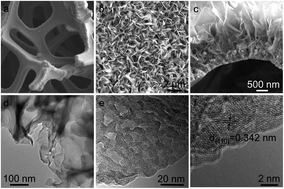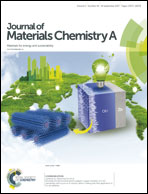Efficient coupling of a hierarchical V2O5@Ni3S2 hybrid nanoarray for pseudocapacitors and hydrogen production†
Abstract
Hierarchical materials are a favourite for energy storage/harvesting technologies, such as supercapacitors and electrically-driven hydrogen production. In this work, we report a robust and highly active nanomaterial for pseudocapacitors and hydrogen production by growing vanadium pentoxide on the surface of nickel sulfide (denoted as V2O5@Ni3S2). V2O5@Ni3S2 shows a capacitance of up to 854 F g−1 at a current density of 1 A g−1 and good rate capability. The capacitance can retain ca. 60% of the initial specific capacitance even after 1000 cycles at a current density of 1 A g−1. For the hydrogen evolution reaction (HER), the overpotential of V2O5@Ni3S2 is around 95 mV at 10 mA cm−2. The excellent electrochemical performance of the V2O5@Ni3S2 hybrid is attributed to the synergistic effect between vanadium pentoxide and nickel sulfide for pseudocapacitors, and the V2O5@Ni3S2 interface and V–S active bonding in the hierarchical structure for the HER. This work demonstrates an effective structure design for supercapacitors with high energy density and for efficient hydrogen production with high catalytic activity by incorporating metal oxide with metal sulfide.



 Please wait while we load your content...
Please wait while we load your content...